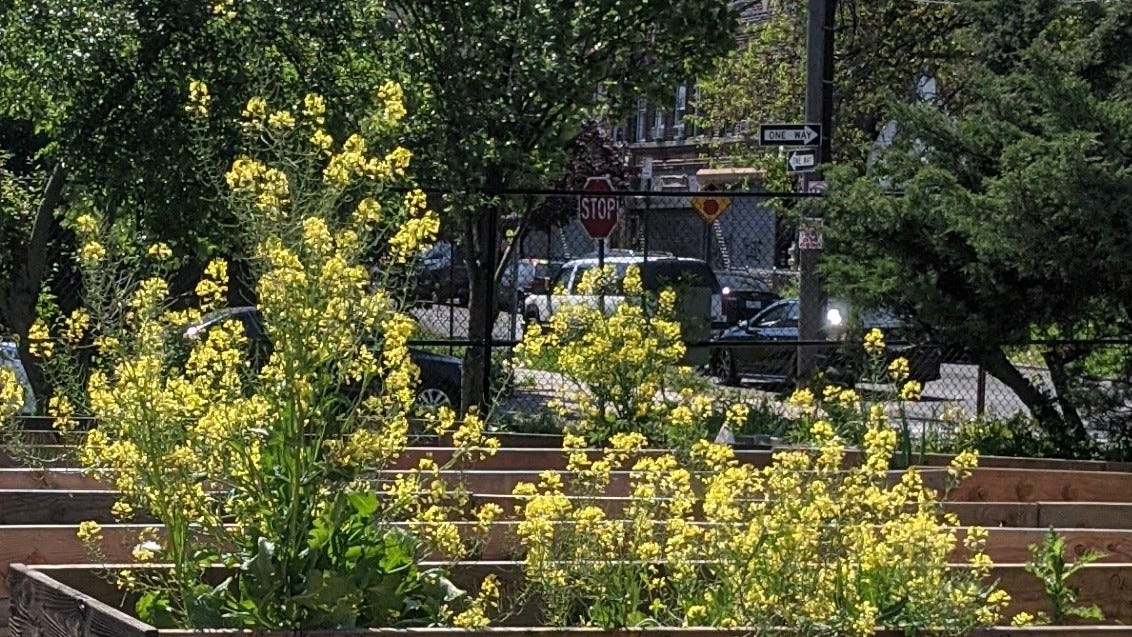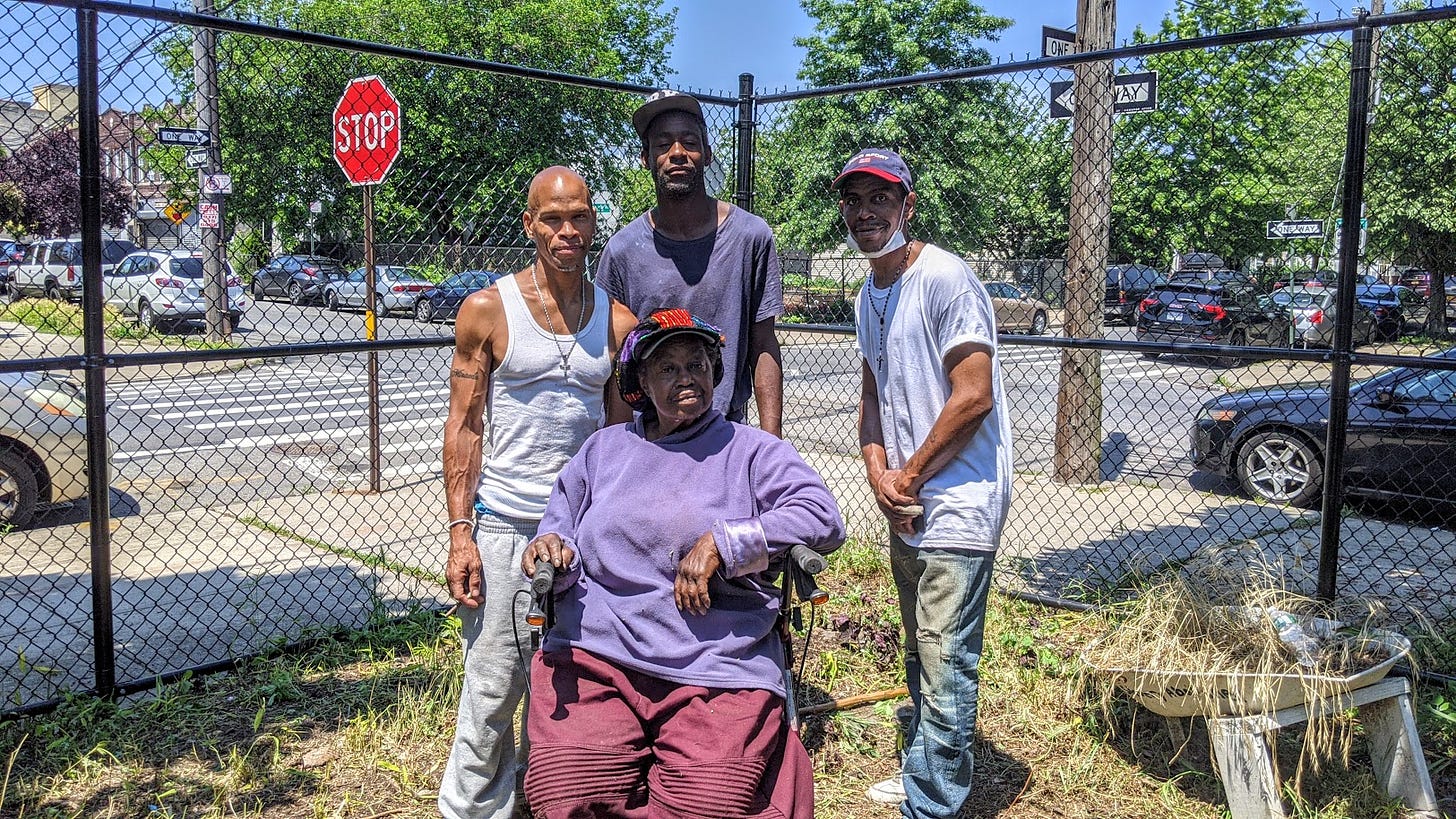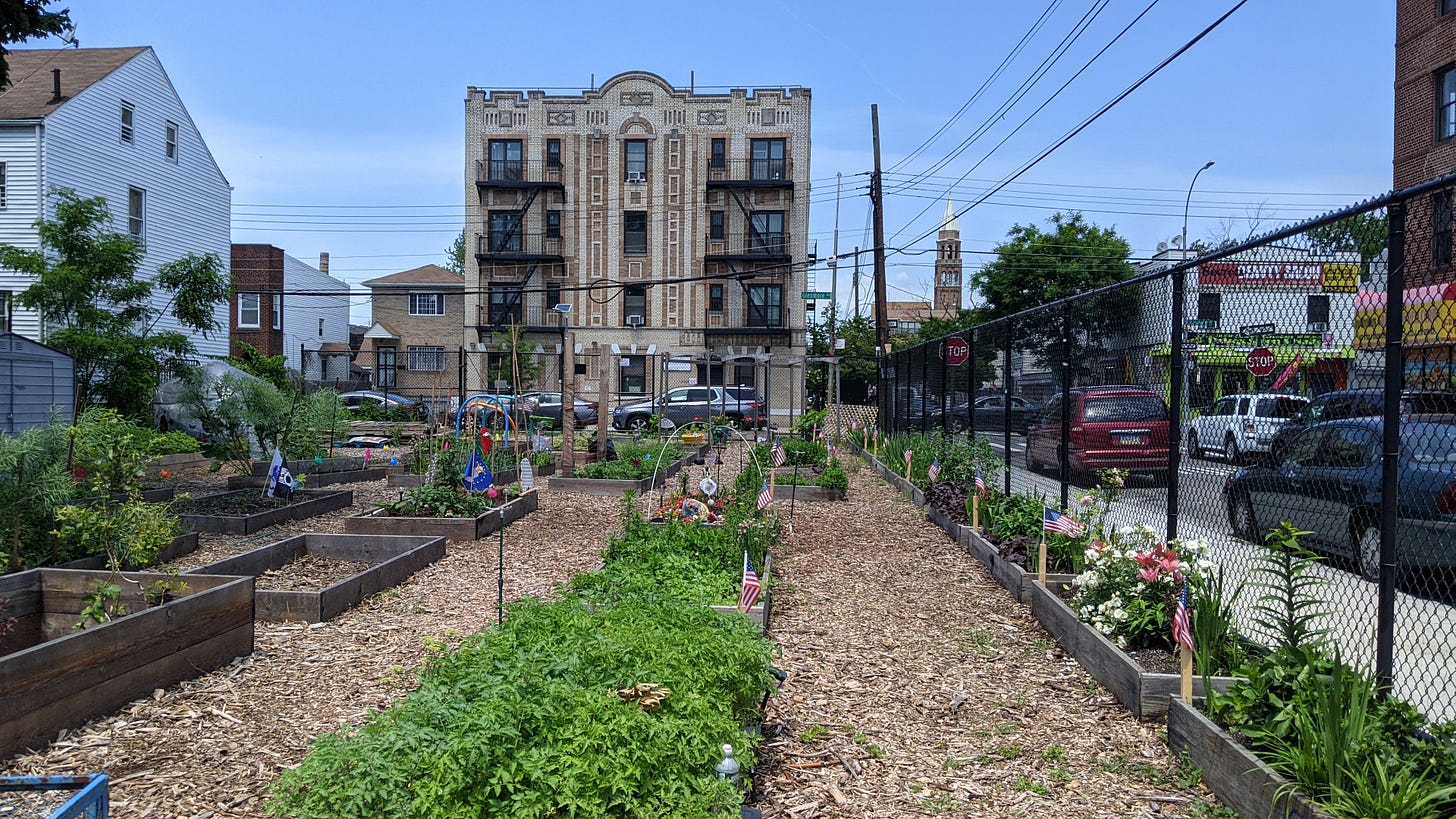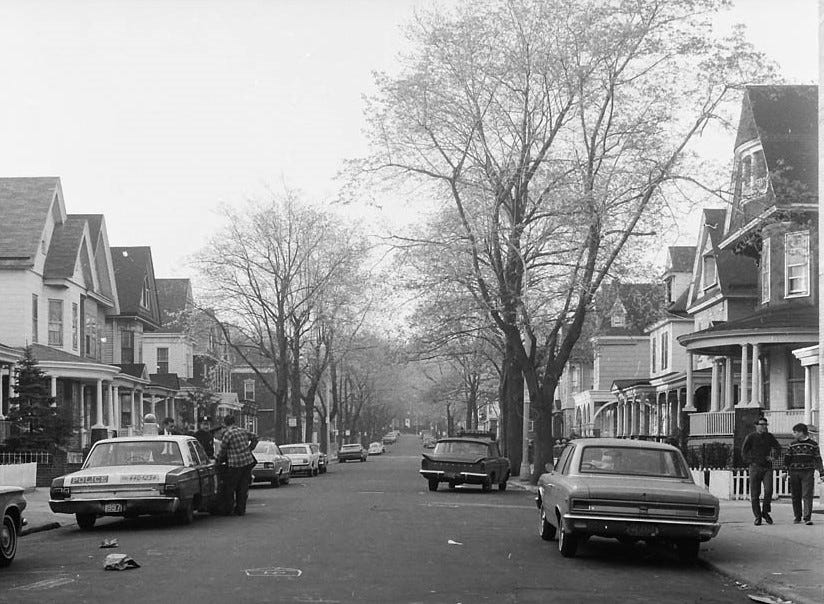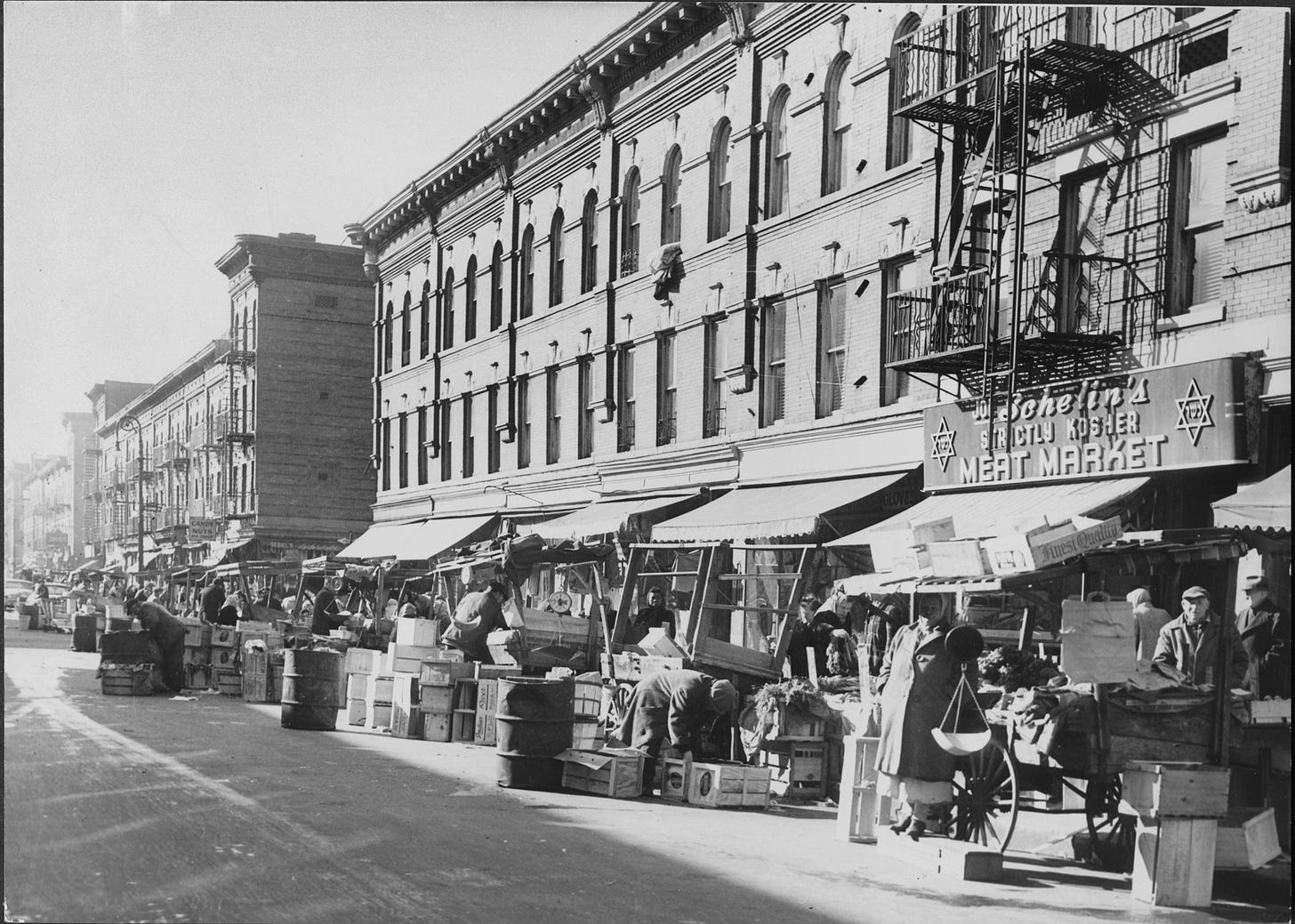Part of a series on one urban garden in East New York
After four days of hard rain, Ms. Johana leans on the men pretty hard. It’s GreenThumb’s annual open garden day, when the public is invited to tour the neighborhood’s gardens from noon to 2 p.m. Many are offering lessons such as beekeeping, bird watching, and composting. Ms. Johana intended to show off her herbal plants and talk about their medicinal properties, but many have gone to seed with the rain and they’re in no shape to show off.
“What’re you doing over there?” She calls to the two in the corner digging up a nasty patch of bamboo. She planted one pot—just one—four years ago and it’s all over the place now, choking off her irises and roses.
“Almost done, Ms. Johana,” one of the men calls back.
She’s lying down on her side to reach for a thatch of thistle weed that took over one of the dormant beds.
“No they’re not,” she says to me. “See that one over there?” She bops her head back toward the picnic tables under the shade of her cherry tree. “The one in the wife beater—that’s what they call it, right—wife beater? Stupid name. ANYWAY, he’s their boss, retired policeman. These two are on work release and got here before 10. He’s good at getting them to work, but you have to keep an eye on them.”
The retired policeman soon walks over and tells her it’s time for them to move on to another garden. “We’ll be back tomorrow,” he says.
“That’s good, because there’s too much that has to be done here.”
“I know, Ms. Johana.”
“What time you’ll be here tomorrow?”
“Nine o’clock. How’s that? Don’t stay out here too long. Going to be hot.”
“Alll right,” she calls out as they walk out the garden gate.
The retired policeman stops on the other side of the fence. Ms. Johana is rolling herself to her feet and dusting dirt off the back of her pants.
“Remember to go over to the other garden. They got plants and food,” he says.
“Alll right.” She waves them off nicely, then turns to the business of pushing her walker over uneven ground.
“Go get that shovel they were using. Don’t have the sense to put it back from where they got it. How they expect me to walk over all that rubble and then drag that heavy shovel back over to where it should be? I don’t know.”
It’s slow going, she and the walker in danger of tilting off the uneven slate walk, and me and her heavy shovel caught up in tangled undergrowth. We pause at the gate.
“After you put the shovel in the shed, go get my backpack on the table and we’ll go see what plants and food they have,” she says.
It’s after lunch time and it doesn’t look promising that any people are coming, so why not? Ms. Johana locks the gate and off we go, around the corner and down two blocks. Few people are about, but those who are call out greetings. She points out what she says is the neighborhood’s last remaining farmhouse. Aluminum siding masks what it would have looked like a good century and a half ago. All the houses we pass are the same, covered in siding, but some retain a few Victorian flourishes along the roofline or in a peculiar jut of what might have been bay windows or side porches. Auto repair shops and a construction company’s storage lot squeeze in between the block houses. Two vacant lots—one a jungle, the other strewn with old refrigerators and car parts—could be longing to be turned into gardens.
The Jerome Glenmore Corner Stone Community Garden has to be one of the prettiest in the neighborhood. Lilies and roses bloom everywhere in the tidy beds decorated with little American flags.
A little awning provides some shade near the entrance, and the people sitting at a card table underneath it tell us to come on over out of the sun. They haven’t had visitors all day.
A big reason why the garden is so orderly is because everyone who works in it lives nearby, most on the same block. Someone is always there working. Two colorful hammocks tied along the leafy side swing with occupants. It also helped that the lot had been cleared and leveled by the city before the garden was laid out.
We take a seat under the tent to wait for the man in charge to be free, joining Helena, Louise, and Joe. Only Joe brightens to hear Ms. Johana say she gave me a tour while walking over.
He says, “I’m like the historian around here. I can tell you about anything.”
He’s a large man, somewhere in his 50s, with close-cut hair and an angel’s smile. He crosses his long arms around his thick chest and settles into the subject.
“When I was coming up, this used to be Jewish, Polish, Italians, and Irish around here.”
“And Puerto Ricans,” Louise adds.
“Yeah, Puerto Ricans. But we all lived together. It was so peaceful and beautiful. You can’t imagine how beautiful it was around here.”
Joe’s father was Mohawk Indian. The family lived in downtown Brooklyn with others from their upstate reservation. They all had jobs building the steel skeletons for skyscrapers and bridges. His mother was Hispanic and grew up in East New York. She wanted to be closer to her family when their children started arriving, so they moved into a house on Warwick Street. Joe thinks he might have been four years old.
“You remember the bagel lady?” Ms. Johana says.
“Oh, the bagel lady! You know where Blake Avenue is?” Joe asks me.
I don’t, but from the tilt of his head it seems to be due west of us.
“That was where all the shops were. You could get anything there. A whole bunch of bananas for like five cents.”
Ms. Johana cuts in. “I used to send my daughter over and she’d get two bagels with butter. The lady had this big ladle and she’d scoop out butter.”
“From a barrel,” Joe adds.
“And she scooped it out of the barrel and put it in wax paper to take home. You talk about a bagel! A bagel was a bagel back then, you didn’t have to eat nothing else all day,” Ms. Johana says.
“They had milk, too,” he says. “From a farm in New Jersey. You know how they poured it in the bottles slowly. . . .”
“That’s so you have the cream nicely on the bottom,” Ms. Johana says.
“There were Jewish butchers, Irish Butchers, German butchers. An Italian butcher paid me to go out hunting for rabbits. I used to go where the sanitation plant is now, used to be swampy around there. Seven years old, and I’d go out there by myself with a bamboo stick with a wire on a hook. What you do is you lay the wire down on the ground and put food in it, then hide in the grass holding the stick. When a rabbit pokes his head in the wire, you pull right up. Then I’d tie his feet together and put it in a bag the butcher gave me and take it to him to kill. I could catch six, eight rabbits in a day.
“That’s how it was around here. It was beautiful around here. Then the riots came in the ‘70s.”
Ms. Johana has finally caught the eye of the garden leader and has gone off to look at the plants and whatever he’s grilling over by the greenhouse. That leaves Helena and Louise to agree with Joe about how suddenly the neighborhood turned.
“All the stores and houses around here burnt down,” Louise says.

“It was bad. Everybody got scared. My father came out of the house to call me in and they shot him in the leg. I was always big for my age but I’d get beat up because I’m Indian. You didn’t know where the attacks would come from. You just had to learn how to survive.
“The whites left. The Jews, all their stores were looted. You’d have gone, right?” Joe says to me, and he, Louise, and Helena wait for me to respond. I can’t say why I don’t tell them I would have.
“You can’t blame them,” Joe says. “My dad got me to go into the Air Force when I turned 18. When I came back, Nehemiah had built houses on the vacant lots.”
Ms. Johana returns to the table. She’s picked out eight large pots of beans and tomatoes. The gardener leader loads them onto a metal wagon for us and we say goodbye.
If possible, it’s gotten even hotter. We walk slowly along, Ms. Johana watching for walker pitfalls in the broken sidewalk, me pulling the plant filled wagon. It’s after two by the time she unlocks the gate. The bottles of frozen water I gave her when I first came are melted manna.
“Did you get anything to eat?” I ask.
“Nothing looked good after thinking about that bagel,” Ms. Johana says.
Hear more stories about growing up and living in East New York through an invaluable collection on the East New York Oral History Project website.


